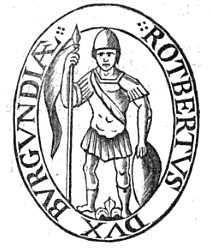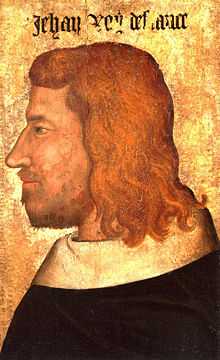Duke of Burgundy

Duke of Burgundy (Fr.: duc de Bourgogne) was a title borne by the rulers of the Duchy of Burgundy, a small portion of traditional lands of Burgundians west of river Saône which in 843 was allotted to Charles the Bald's kingdom of West Franks. Under the Ancien Regime, the Duke of Burgundy was the premier lay peer of the kingdom of France.
Beginning with Robert II of France, the title has been held by the Capetians, the French royal family. It was granted to Robert's younger son, Robert, who founded the House of Burgundy. When the senior line of the House of Burgundy became extinct, it was inherited by John II of France through proximity of blood. John granted the duchy as an appanage for his younger son, Philip the Bold. The Valois Dukes of Burgundy became dangerous rivals to the senior line of the House of Valois. When the male line of the Valois Dukes of Burgundy became extinct, it was confiscated by Louis XI of France. From then on, the title was never given again to a younger son.
Today, the title is used by the House of Bourbon as a revived courtesy title.
List of Dukes of Burgundy
Bosonid dynasty (880-956)
.svg.png)
The first margrave (marchio), later duke (dux), of Burgundy was Richard of the House of Ardennes, whose duchy was created from the merging of several regional counties of the kingdom of Provence which had belonged to his brother Boso.
His descendants and their relatives by marriage ruled the duchy until its annexation over a century later by the French crown, their suzerain.
- Richard the Justiciar (880–921)
- Rudolph (921–923), then King of France
- Hugh the Black (923–952)
- Gilbert (952–956)
Robertian dynasty (956-1004)
- Otto (956–965)
- Eudes Henry the Great (965–1002)
- Otto William (1002–1004)
House of Capet (1004-1032)
In 1004, Burgundy was annexed by the king, of the House of Capet. Otto William continued to rule what would come to be called the Free County of Burgundy. His descendants formed another House of Ivrea.
- Robert (1004–1016) (also king of France as Robert II)
- Henry (1016–1032) (also king of France as Henry I)
House of Burgundy (1032–1361)
Robert, son of Robert II of France, received the Duchy as a peace settlement, having disputed the succession to the throne of France with his brother Henry.
| Picture | Name | Birth | Became Duke | Ruled until | Death | Notes |
|---|---|---|---|---|---|---|
 | Robert I the Old (Robert Ier le Vieux) | 1011 | 1032 | 21 March 1076 | Younger son of Robert II of France. | |
| Hugh I (Hugues Ier) | 1057 | 21 March 1076 | 1079 | 29 August 1093 | Eldest son of Henry of Burgundy, grandson of Robert I. Abdicated in favour of his younger brother, Odo. | |
 | Odo I Borel the Red (Eudes Ier Borel le Roux) | 1058 | 1079 | 23 March 1103 | Younger brother of Hugh I. | |
 | Hugh II (Hugues II) | 1084 | 23 March 1103 | 1143 | Son of Odo I | |
 | Odo II (Eudes II) | 1118 | 1143 | 27 June/27 September 1162 | Eldest son of Hugh II | |
 | Hugh III (Hugues III) | 1142 | 27 June/27 September 1162 | 25 August 1192 | Eldest son of Odo II | |
 | Odo III (Eudes III) | 1166 | 25 August 1192 | 6 July 1218 | Eldest son of Hugh III | |
 | Hugh IV (Hugues IV) | 9 March 1213 | 6 July 1218 | 27 October 1271 | Eldest son of Odo III | |
 | Robert II (Robert II) | 1248 | 27 October 1271 | 21 March 1306 | Eldest surviving son of Hugh IV. | |
 | Hugh V (Hugues V) | 1282 | 21 March 1306 | 9 May 1315 | Eldest son of Robert II. | |
 | Odo IV (Eudes IV) | 1295 | 9 May 1315 | 3 April 1350 | Younger brother of Hugh V. | |
 | Philip I of Rouvres (Philippe Ier de Rouvres) | 1346 | 3 April 1350 | 21 November 1361 | Grandson of Odo IV. | |
House of Valois-Burgundy (1361–1482)
John II of France, the second Valois king, successfully claimed the Duchy after the death of Philip, the last Capet duke. John then passed the duchy to his youngest son Philip as an apanage.
| Picture | Name | Birth | Became Duke | Ruled until | Death | Notes | Arms |
|---|---|---|---|---|---|---|---|
 | John I the Good (Jean Ier le Bon) | 16 April 1319 | 28 December 1361 | 6 September 1363 | 8 April 1364 | Also John II of France. Successfully claimed the Duchy as the nearest heir in proximity of blood to Philip I. |  |
 | Philip II the Bold (Philippe II le Hardi) | 15 January 1342 | 6 September 1363 | 27 April 1404 | Youngest son of John the Good | .svg.png) | |
 | John II the Fearless (Jean II sans Peur) | 28 May 1371 | 27 April 1404 | 10 September 1419 | Eldest son of Philip the Bold | .svg.png) | |
 | Philip III the Good (Philippe III le Bon) | 31 July 1396 | 10 September 1419 | 15 June 1467 | Eldest son of John the Fearless |  | |
 | Charles I the Bold (Charles Ier le Téméraire) | 21 November 1433 | 15 June 1467 | 5 January 1477 | Eldest son of Philip the Good |  | |
.jpg) | Mary the Rich | 13 February 1457 | 5 January 1477 | 27 March 1482 | Only daughter of Charles the Bold |  | |
House of Habsburg (1482–1700)
In 1477, the territory of the Duchy of Burgundy was annexed by France. In the same year, Mary married Maximilian, Archduke of Austria, giving the Habsburgs control of the remainder of the Burgundian Inheritance.
Although the territory of the Duchy of Burgundy itself remained in the hands of France, the Habsburgs remained in control of the title of Duke of Burgundy and the other parts of the Burgundian inheritance, notably the Low Countries and the Free County of Burgundy in the Holy Roman Empire. They often used the term Burgundy to refer to it (e.g. in the name of the Imperial Circle it was grouped into), until the late 18th century, when the Austrian Netherlands were lost to French Republic. The Habsburgs also continued to claim Burgundy proper until the Treaty of Cambrai in 1529, when they surrendered their claim in exchange for French recognition of Imperial sovereignty over Flanders and Artois.
- Maximilian I (1477–1482 with his wife; regent 1482–1494)
- Philip IV the Handsome (German: Philipp der Schöne; French: Philippe le Bel), titular Duke of Burgundy as Philip IV (1482–1506)
- Charles II (Emperor Charles V and King Charles I of Spain) 1506–1555
| Picture | Name | Birth | Became Duke | Ruled until | Death | Notes | Arms |
|---|---|---|---|---|---|---|---|
 | Philip IV the Handsome (Philippe IV le Bel) | 22 July 1478 | 22 February 1482 | 25 September 1506 | Eldest son of Duchess Mary by Maximilian of Habsburg |  | |
 | Charles II | 24 February 1500 | 25 September 1506 | 16 January 1556 | 21 September 1558 | Eldest son of Philip the Handsome. Also Charles I of Aragon and Castile, and Holy Roman Emperor Charles V | |
- Philip V (King Philip II of Spain) 1556–1598
- Philip VI (King Philip III of Spain) 1598–1621
- Philip VII (King Philip IV of Spain) 1621–1665
- Charles III (King Charles II of Spain) 1665–1700
House of Bourbon, claimants of the title (1700-1713)
The title was briefly claimed by king Philip V of Spain (Philip VIII) of the House of Bourbon between 1700–1713 when the succession of the Spanish throne was disputed between the Houses of Habsburg and Bourbon.
At the same time, various members of the French royal family, most notably Louis, Dauphin of France, the father of Louis XV of France, also used the title.
House of Habsburg (1713–1795)
- Charles IV (Emperor Charles VI) 1713–1740
- Maria Theresa 1740–1780
- Francis I (Emperor Francis I) (1740–1765 with his wife.)
- Joseph (Emperor Joseph II) 1780–1790
- Leopold (Emperor Leopold II) 1790–1792
- Francis II (Emperor Francis II) 1792–1795
House of Bourbon, revived title in contemporary tradition (1975-present)
- King Juan Carlos I of Spain (1975–present) - the title is one of the titles of the Spanish Crown
- Prince Louis of Bourbon (2010–present) - the title is used by eldest son of the legitimist claimant to the French throne Louis Alphonse, Duke of Anjou.
See also
- Duchess of Burgundy
- Kingdom of Burgundy
- King of Burgundy
- Duchy of Burgundy
- County of Burgundy
- Count of Burgundy
- Dukes of Burgundy family tree
Further reading
- Calmette, Joseph. Doreen Weightman, trans. The Golden Age of Burgundy; the Magnificent Dukes and Their Courts. New York: W.W. Norton, 1962.
- Chaumé, Maurice. Les Origines du Duché de Bourgogne. 2v. in 4 parts. Dijon: Jobard, 1925 (Darmstadt: npub, 1977).
- Michael, Nicholas. Armies of Medieval Burgundy 1364–1477. London: Osprey, 1983. ISBN 0-85045-518-9.
- Vaughan, Richard. Valois Burgundy. London: Allen Lane, 1975. ISBN 0-7139-0924-2.
| Wikimedia Commons has media related to Dukes of Burgundy. |